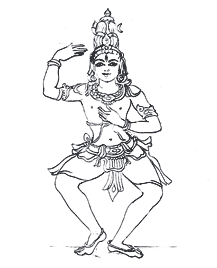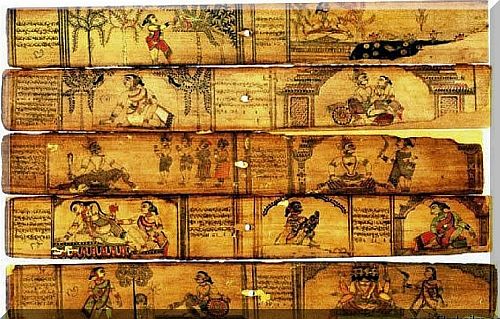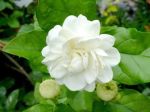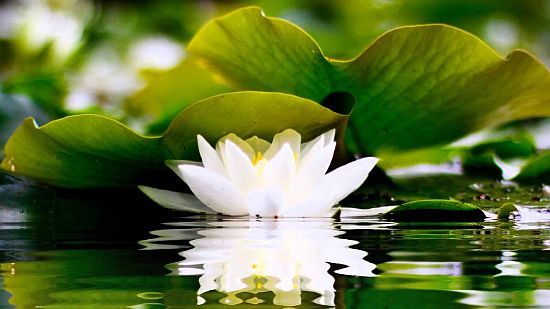Lakshana Granthas – continued
5, Abhinavabharati

The Natyaveda-Vivritti, more famously celebrated as Abhinava-bharati is the most well known commentary by Abhinavagupta on the Natyashastra of Bharata. It is one among the handful of commentaries that are as renowned, if not more, as the texts on which they commented upon. Abhinavagupta illumines and interprets the text of Bharata at many levels: conceptual, structural and technical. He comments, practically, on its every aspect; and his commentary is a companion volume to Bharata’s text.
The earliest surviving commentary on the Natyashastra is the Abhinavabharati by Abhinavagupta. It was followed by the works of commentators like Saradatanaya (12th century), Sarangadeva (13th century) and Kallinatha (16th century). However, Abhinavabharati is regarded as the most authoritative commentary on Natyashastra ; because, Abhinavagupta provides not only his own illuminating observations and interpretations, but also gives wide range of information about the works of the scholars earlier to his period , most of which are now lost.
Abhinavagupta, who lived in Kashmir by about the late tenth and early eleventh century, was a visionary endowed with incisive intellectual powers of a philosopher who combined in himself the experiences of a mystic and a Tantric. He was equipped with extraordinary skills of a commentator and an art critic
Abhinavagupta dealt with almost every important aspect of Indian aesthetics in his two commentaries – Kavya-loka-locana (called, in short, as Locana, a commentary on the Dhvanyaloka of Anandavardhana); and, the Abhinavabharati (a detailed commentary on the Natyashastra of Bharata).
These are the two well known aesthetic works of Abhinavagupta; for which he is celebrated as the principal exponent of aesthetic theory (Rasa-vada). In his Locana, he firmly established the concept of Vyanjana -Vritti or Dhvani or the suggestive power of the words as the best form of poetic expression. And, the Abhinavabharati is the best guide to understand Bharata
These two commentaries influenced and guided the subsequent generations of authors and critics; especially in regard to the aesthetic experience (Rasanubhava). No succeeding writer or commentator could ignore Abhinavagupta’s commentary; and his discussions on two crucial chapters of the Natyashastra namely, the Sixth and the Seventh on Rasa and Bhava.
His work came to be recognized as a text of indisputable authority (Pramana grantha); and, was regarded as the standard work, not only on Music and Dance, but also on poetics (Almkara shastra) as well. Hemachandra in his Kavyanusasana; Ramachandra and Gunachandra in their Natyadarpana; Kallinatha in his commentary on the Sangita-ratnakara; and, Saradatanaya in his Bhava-prakasana, very often refer to Abhinavagupta. The chapter on Dance in Sarangadeva’s Sangita-ratnakara is almost entirely based on Abhinava’s work. And, similar is the case with Jaya Senapati’s Nrttaratnavalli. The noted scholar Dr. V Raghavan, therefore, remarked: ‘So what is often taken today as the influence of the Natyashastra in these texts is in reality the influence of Abhinavagupta.’
*
Between the time of Bharata and the Eleventh century , many commentaries on Natyashastra were written ; and, many other independent treatise on dramatics were composed by several authors such as Kohala, Rahula, Dattila, Harsha, Nandikesvara , Varattikakara and others . But, those works are no longer extant, except for a few verses cited in the later texts on Drama, Dancing and Music.
And, many scholars who hailed from the region of Kashmir; and, who preceded Abhinavagupta, had also produced brilliant commentaries on Poetics , Music and Dramaturgy , with special reference to Rasa, Bhava, Abhinaya, Nayika Nayaka’s and construction and presentation of drama with its varieties. Among those scholars were Bhattalollata, Udbhata, Shankuka, Bhattanayaka and Kirtidhara, as mentioned in Sangita-ratnakara.
But, sadly, all those works are no longer extant; except for a few verses cited in the later texts on Drama, Dancing and Music.
It is only through the efforts of Abhinavagupta that the works of all those masters can only be partially reconstructed through references to them in his Abhinavabharati. Further, Abhinavagupta also brought to light and breathed life into ancient and forgotten scholarship of fine rhetoricians Bhamaha, Dandin and Rajashekhara.
It is through Abhinavagupta’s quotations from Kohala, whose work is occasionally referred to in the Natyashastra, that one can reconstruct some of the changes that took place in the intervening period between his time and that of Bharata’s.
And, in regard to Dance, since a number of works on dancing that were known to have been written after Bharata are now lost, it is difficult to follow the discussions concerning the developments in the field of Dancing that took place during the early period of its evolution , without the aid of Abhinavabharati.
Abhinavagupta also drew upon the later authors to explain the application of the rules and principles of Natya. For instance; he quotes from Ratnavali of Sri Harsha (7th century); Venisamhara of Bhatta Narayana (8th century); as also cites examples from Tapaas-vatsa-rajam of Ananga Harsa Amataraja (8th century) and Krtyaravanam .
In addition, Abhinavagupta introduced many improvements and new thoughts into the system of Sanskrit literary criticism, which have been accepted by all the later writes and commentators, beginning with Mammata Bhatta in the eleventh century and ending with Jagannatha Pandita in the 17th century
The Abhinavabharati thus serves as a bridge between the world of the ancient and forgotten wisdom and the scholarship of the succeeding generations. And, Abhinavagupta himself said that he wrote the commentary in order to save and perpetuate the ancient tradition.
Evam anyad api ūhyam iti an-upayogyāt samastaṁ na likhitam āgama-bhraṁsa-rakṣanāya tu diṅ nirupitā

The Abhinavabharati, though basically a commentary on and a companion volume to Bharata’s Natyashastra, is, for all purposes, an independent work in its own right. It, again, is a detailed exposition on various subjects such as: drama, dance, poetry, music, art, prosody and also aesthetics with reference to Anandavardhana’s Dhvanyaloka (820-890). Abhinavagupta comments on a range of subjects, at different levels. He cites and discusses the views of many ancient authorities who wrote on drama, dance, music etc. He illustrates the principles and its application in Natya, through examples taken from well-known Dramatic works.
Abhinavagupta not only expands on Bharata, but also interprets him in the light of his own experience and knowledge; and, also with references to the then current practices. And, at many places, he differs from Bharata; and, introduces concepts and practices that were not present during Bharata’s time. For instance; the concept of minor dramas was absent in the Natyashastra. But, Abhinavagupta, in his commentary, speaks of minor categories of drama (Uparupakas); and calls them as Nrtta-kavya and Raga-kavya. These were the type of plays where the narration through Dance and Music is prominent.
Similarly, Abhinavagupta provides the details of several dance forms that are mentioned but not described in the Natyashastra. For instance; he describes Bhadrasana, one of the group dances termed Pindibandha by Bharata but not described by him- piṇḍīnāṃ vividhā yoniryantraṃ bhadrāsanaṃ tathā ॥NS.4. 290॥
Abhinavagupta, thus, comments, practically, on every aspect of Natyashastra. Further, he brings in the concepts of his School pratyabhijna, while interpreting Bharata’s text.
The works of the later writers (such as: Mammata, Hemachandra, Saradatanaya and others) clearly bear the influence of Abhinavagupta.
[Dr. Mandakranta Bose, who examined the text critically, observes: Even though his commentary is illuminating in general, there are places where his explanations are not enough to visualize the movements he describes. Since the edited text is often corrupt, the task of understanding is even harder. The movements are sometimes unclear and impossible to reproduce. However, as the single extant commentary on Bharata’s seminal text, Abhinavagupta’s work has exerted great influence on subsequent writers on dance, drama and on Alamkara as well.]
*
The importance of Abhinavagupta’s work can hardly be overstated. And, Abhinavabharati is the best guide to understand Bharata. The learned scholar Dr. K Krishnamoorthy in his Indian Literary Theories (1985) writes:
If Bharata is the father figure hallowed by the tradition, and revered by all the later writers; Abhinavagupta is the sole interpreter to us of not only Bharata’s thoughts, but also of the writers of those authors over several centuries , between the time of Bharata and Abhinavagupta, since he sums up all the traditions of various Schools and enlivens it by his own illuminating and original thinking.
His work is the only source for all the accumulated knowledge of on the subject in the golden age of Indian history. There is perhaps no other single work in the wide range of literary, technical and philosophical treatise that matches the Abhinavabharati. Such is the incandescent lustre of the far- flung genius of Abhinavagupta.
If Bharata is the Panini of the Indian theatrical lore, then Abhinavagupta is his Patanjali. His work is not a mere commentary; but, often an original dissertation.

The Abhinava-bharati follows the Natyashastra, chapter by chapter, except for the Seventh, the Eighth, and the Thirty-third to Thirty-seventh.
Abhinavagupta’s text ends with Chapter Thirty-seven while most of the other versions of the text end with the Thirty-sixth. At the commencement of his commentary, Abhinavagupta mentions that the Natyashastra of Bharata consists Thirty-six Chapters. Thereafter, at the beginning of each successive Chapter of his commentary, he praises the deity representing the corresponding Tattva, beginning with Bhumi or Prithi, the principle of Earth. And, the last Chapter of his commentary, that is the Thirty-seventh, commences with salutations to Anuttara, the Supreme Reality beyond which there is nothing, therefore, free from all limitations – Na vidyate uttaram prana prati vacorupam yatra. And, Anuttara is Parama Shiva, the Absolute, the primal source of all existence.
[The 36 Tattvas as per Kashmir Shaiva philosophy are : Five Physical Elements or Mahabhuta (Prithvi, Jala, Agni, Vayu and Akasha); Five sensations or Tanmatras (Rupa, Sparsha , Rasa, Gandha, and Sabda); Five sense organs or Jnanedriyas (Upastha, Payu, Pada, Pani and Vac); Five Sense experiences (Grahana, Tvacha, Rasana, Chakshu, and Srotra); Three mental functions (Manas, Ahamkara and Buddhi); Prakrti; Purusha; Six limited individual experiences (Niyati, Kala, Raga, Vidya, Kala and Maya); Five Tattvas of Universal experience (Shudda vidya, Isvara, Sadashiva , Shakthi and Shiva)- please check here and then go to page 25 of the Book (page 36 of PDF document).]
The reason for the extension of the number in Abhinava-bharati seems to be that the Shaiva Siddantha recognizes Thirty-six Tattvas (principles); and when that is extended, the Thirty-seventh is said to represent the concept of Anuttara (the ultimate or nothing beyond) a doctrine of the Pratyabhijna System of philosophy propounded by Utpaladeva the Parama-guru (the teacher’s teacher) of Abhinavagupta
Of the thirty-seven Chapters in the Natyashastra; about twelve Chapters are related to Dance. They are the Chapter numbers: 4, 5, 8-13, 19, 21, 22, 25 and 31.
[Please click here for volumes of Natyashastra with commentary of Abhinavabharati: For Volume One by Dr. K .Krishnamoorthy; For Volume Two by Pandit M. Ramakrishna Kavi; and, Volume Three by Pandit M. Ramakrishna Kavi.]

As regards the Angikabhinaya, Abhinavagupta, generally, follows Bharata, rather closely.
In the Fourth Chapter of his commentary, Abhinavagupta deals with the definition and the division of 108 Karanas which constitute the fundamental dancing poses.
Abhinavagupta explains: Karana is indeed the harmonious combination (sam-militam) of Gati (movement of feet), Sthanaka (stance), Cari (foot position) and Nrtta-hastha (hand-gestures)
Gatau tu Caryah / purvakaye tu Gatau Nrttahastha drusta-yashcha / sthithau pathakadyaha tena Gati-Sthithi – sam-militam Karanam
As regards Gati (gait) , Abhinavagupta also mentions that in the Nrtta though the Gati could generally follow the Natyadharmi, one should also keep in view the context of the times, the situation (desham, kalam) and the prevalent practices
Cari, Mandala prasangasya chitta-vrttitvad Gati viniyoga meva pratijanite/ Gatisha prakrutim rasa-avastham desham kalam cha apekshya vakthavya prati purusha abhidanath
According to Abhinavagupta, Karaṇa is action (Kriyā Karaṇam); and, as the very life (jivitam) of Nṛtta, the pure dance movements. It is a Kriya, an act which starts from a given place and terminates after reaching the proper one. It involves both the static and dynamic aspects: pose (Sthiti) and movement (Gati).
And that is why, he says, Karaṇa is called as ‘Nṛtta Karaṇa’. Such throws (kṣepa) of the limbs must be guided by a sense of beauty and grace (vilasa-ksepasya). A Karana has to be intellectually and spiritually satisfying. The word nṛttasya in Bharata’s definition is meant to emphasize this aspect of dance.
Kriya karanam. Kasya kriya. nrttasya gatranam vilasakhepasya heyopadeya visaya kriya adibhyaf; vyatirikta ya tatkriya karanam itya artha.
According to him, the Sthanaka (posture), Cari (foot-position) and Nrtta-hastha (hand-movements) can be compared to subject (kartru-pada), object (Karma-pada) and verb (Kriya-pada) in a meaningful sentence; while the resultant Karana could be compared to a sentence.
As regards Recakas (circular movement of a limb), Abhinavagupta says: it is through the Recakas that the Karanas and the Angaharas derive their beauty and grace. He gives some guidelines to be observed while performing a Recaka of the foot (Pada-recaka) , neck (Griva-recaka) and the hands (Hastha-recaka) .
According to him; while performing the Recaka of the foot one should pay attention to the movements of the big toe; in the Recaka of the hands one should perform Hamsa-paksha Hastha in quick circular movements; and, in the Recaka of the neck one should execute it with slow graceful movements.
Padayoreva chalanam na cha parnir bhutayor antar bahisha sannatam namanonna manavyamsitam gamanam Angustasya cha /Hasthareva chalanam Hamsapakshayo paryayena dhruta bramanam/ Grivayastu Recitatvam vidhuta brantata//
After the discussion of Karanas, Abhinavagupta deals with the definition and division of Angaharas, which are made of Karanas – Nānā Karaṇa saṃyuktair Aṅgahārair vibhūṣitam (NS.4.13). Abhinavagupta explains Aṅgahāra as the process of ‘sending the limbs of the body from a given position to the other proper one (Angavikshepa). And, such Angavikshepa is said to be a dominant feature of the Nrtta. And, that term stands for graceful composition of limbs (gatram vilasena-kshepaha). Thus, the Angaharas, basically, are Nrtta movements, the Angika-abhinaya, involving six Angas or segments of the body.

Abhinavagupta comments on seven divisions of Nrtta. The first three are to be used in independent Laukika dance, for the satisfaction of the deities. The last four are employed in the preliminaries.
Abhinavagupta classifies Nrtta into two broad Groups; the first group having three types; and, the second having four types. Thus, the Nrtta, in all, is classified by Abhinavagupta into seven types.
The First Group belongs to the pure Nrtta type; whereas, the Second Group relates to of what came to be known as Nrtya, which involves Abhinaya. Abhinavagupta, in his explanations, did not, however, use the term Nrtya.
The First Group of Nrtta that Abhinavagupta formulated has the three types: (1) Shuddha-Nrtta; (2) Gitakad-abhinayao-nmukha-Nrtta; and, (3) Vadya –Talanusari Nrtta.
Here, Shuddha, that is, pure or abstract dance; the Gitakad-abhinay-onmukha is a dance that expresses the meaning of a song; and, the Vadya-talanusari is a dance that follows instrumental music and rhythm.
The Second Group of Nrtta has four types: (1) Uddhata Nrtta ;(2) Masrana-Nrtta; (3) Misra Uddhata Nrtta; and,(4) Misar-Masarna Nrtta.
And, here, the Uddhata is a vigorous dance; the Masrana is a dance with delicate and graceful movements (Sukumara); the Misra Uddhata Nrtta is a vigorous dance mixed with delicate movements; and, the Misar-Masarna Nrtta is a delicate dance mixed with vigorous movements.
Since many of these dances in the Second group were expressive, they required Abhinaya or interpretative movements. Such dances, then, fall into the category that later became known as Nrtya. Abhinavagupta, however, does not use the term Nrtya, perhaps because Bharata spoke only of Nrtta; and, had not used the term Nrtya.

The commentary on the Fifth Chapter expands on Bharata’s description of the preliminaries of the performance of the play and remarks on theatrical terms like Purvaranga, Naandi, and Dhruva etc.
The subject of Dhruva, which is the song to be sung in the course of the play, is discussed in detail. Natyashastra (NS: 32.32) explained the Dhruva Gana as the well composed songs that are steadfast (Dhruva) in the principles of Pada (words), Varna (syllables) and Chhandas (meter)
Natyashastra had devoted one entire and a lengthy chapter (Chapter 32) to discuss the Dhruva songs. That was because; the songs formed an essential ingredient of the play. And, Bharata said: without songs, the Drama is incapable of providing joy (NS. 32. 482): Just as a well-built dwelling house (citraṃ niveśanaṃ) does not become beautiful and provide a pleasant ambiance without any colour; so also a Drama without any songs does not provide much joy.
Abhinavagupta, accordingly, deals with the Dhruva songs, in fair detail. He explains that the Dhruva songs help to enhance the artistic sense of the important themes that occur in various situations in a play.
While commenting on the term Dhruva, Abhinavagupta explains that these types of songs were called Dhruva ( = standpoint; locus of reference) because in it, the Vakya (sentence), Varna (syllables) , Alamkara (grace notes), Yatis (succession of rhythm patterns) , Panyah (use or non-use of drums) and Laya (beats) were harmoniously fixed ( Dhruvam) in relation to each other – (anyonya sambandha) .
Vakya –Varna–Alamkara yatyaha -panayo-layah I Dhruvam-anyonya sambandha yasmath smada Dhruva smrutah II
He further says, the composition (pada samuha) structured as per a rule (niyatah) and that which supports (adhara) singing could be called Dhruva (Dhruvah- Gitya-adhara niyatah pada –samuha).
At another place, Abhinavagupta explains Dhruva as the basis or the support (adhara) on which the song rests. Abhinavagupta says: just as the painting is supported by wall, the Dhruva song is supported by Pada (word). And, Pada in turn is supported by, the Chhandas (meter) – (Abhinavagupta: NS.32.8).
Thus, in the Dhruva Gana, the words of the song are regulated by Chhandas. And, the words are then set to appropriate tunes and Taala-s.

The Sixth Chapter is described as Rasadhyaya; because it mainly deals with concept and the theories of Rasa, the aesthetic pleasure, the essence of all Art experience. Though this Chapter is not directly related to Dance, we may take a brief look at it; because, this Chapter is considered as one of the very important Chapters in the Natyashastra ; and also because , Abhinavagupta discussed the various aspects of the Rasa-doctrine (Rasa-siddantha) in great detail. And, in the process, he dealt with almost every important facet of Indian aesthetics. Abhinavagupta’s contribution to the revision of Indian aesthetics is truly outstanding.
In this Chapter, Abhinavagupta interprets, mainly, eleven elements of the Natya. They are: Rasa, Bhava, Abhinaya, Dharmi, Vrtti, Pravrtti, Siddhi, Svara, Atodya, Gana and Ranga. Among these, the Rasa is regarded as one of the most important theoretical aspects of the Natyashastra. According to Bharata, Rasa is the sum and substance of all Art- expressions; and, no sense proceeds without Rasa – Na hi rasādṛte kaścid arthaḥ pravartate (prose passage after verse 31, in Chapter Six).
The Natyashastra asserts that the goal of any Art form is to invoke Rasa, the aesthetic enjoyment in the mind and heart of the cultured spectator (sumanasaḥ prekṣakāḥ or Sahrudaya). And, such enjoyment is an emotional or an intellectual experience: āsvādayanti manasā tasman nāṭya- rasāḥ smṛtāḥ (N.S.6.33).
The Chapters Six and Seven in the Natyashastra have been the mainstay of the Rasa concept in all traditional literature, dance and theatre arts in India. Bharata says that which can be relished – like the taste of food – is Rasa –Rasyate anena iti rasaha (asvadayatva). Though the term Rasa is associated with palate, it is equally well applicable to the delight afforded by all forms of Art; and, the pleasure that people derive from their art experience. It is literally the activity of savouring an emotion in its full flavour. The term might also be taken to mean the essence of human feelings.
[The Rasa-doctrine is also relevant to classical dance, particularly since its performance is pervaded by emotion; and, its presentation, in varied graceful and meaningful forms (Abhinaya), attempts to express those emotions. Further, the Rasa-principle also provides a philosophical framework for explaining the fundamentals of an aesthetic experience; and, how it relates to the human psychological processes.]
The famous Rasa sutra or the basic formula to invoke Rasa, as stated in the Nātyashāstra, is: vibhāva anubhāva vyabbhicāri samyogāt rasa nispattih (prose passage after verse 31, in Chapter Six).
Here, the Vibhāva represents the causes, while Anubhāva is the manifestation or the performance of its effect communicated through the Abhinaya. The more important Vibhāva and Anubhāva are those that invoke the Sthāyi-bhāva, or the principle emotion at the moment of the performance. The Sthayi-bhava combines and transforms all other Bhavas; and, integrates them with itself.
Thus, the Rasa-sutra states that the Vibhāva, Anubhāva, and Sanchari or the Vyabhicāri-bhāvas coming together (samyogād) with the Sthayi-bhava result in Rasa (rasa nispattih).
Abhinavagupta, in his commentary, initially takes a review of the explanations given by the previous authorities and scholars; then sums them up; and, later provides his own comments and explanations. He remarks that he is formulating his own theories on the foundation laid by others; and, his views are only an improvement on what has been said by the earlier interpreters.
Abhinavagupta begins by explaining his view of aesthetics and its nature. Then goes on to state how that aesthetic experience is created. During the process, he comments on Bharata’s concepts and categories of Rasa and Sthayi-bhava, the dominant emotive states, and of Sattvika, the involuntary bodily reflexes. He also examines Bharata’s other concepts of Vibhava, Anubhava and vyabhichari (Sanchari) bhavas and their subcategories Uddipana (stimulant) and Aalambana (ancillaries).
Abhinavagupta comments on these concepts in the light of Shaiva Pratyabhijna philosophy; and explains the process of One becoming many and returning to the state of repose (vishranthi)). He also brings in the elements of Abhivyakti (an expression that suggests release from ignorance, resulting in Camatkara); and Dhvani (aesthetic-suggestions) as expounded by Anandavardhana (820-890) in his Dhvanyaloka.
[At places, Abhinavagupta uses the term Samvitti, in place of Rasa, as a synonym. He also uses the term Visranti to denote the state of aesthetic experience, which is a state of complete repose. These terms (Samvitti and vishranthi) are used in the Shaiva Pratyabhijna philosophy to represent Ananda, the absolute bliss. And, Abhivyakti is also a term of that branch of philosophy.]
For Abhinavagupta, soaked in sublime principles of Shaiva Siddantha, the aesthetic experience is Ananda, the unique bliss. He regards such aesthetic experience as different from any ordinary experience; and, as a subjective realization. It is Alukika (out of the ordinary world), he said, and is akin to mystic experience. That experience occurs in a flash as of a lightening; it is a Chamatkara, the state of blissful aesthetic experience. It is free from earthly limitations; and, is self luminous (svaprakasha). It is Ananda; a direct experience; a state of pure and undefiled joy. This Rasa-ananda, he says, is almost to be equivalent to the philosophic bliss (Brahma-ananda)
Abhinavagupta interpreted Rasa as a ‘stream of consciousness’ (Caitanya-Vahini) that is not restricted by time and place.
Sa ca rasana na pramanya vyaparo na kara kavya aparah svayam tu na apramanikah /
As regards poetic experience, according to Abhinavagupta, its Rasa is in understanding (rasana ca bodha-rupaiva) the essential inner meaning of Kavya – tatkavyartho rasah. It is realized by the cultured reader with empathy (Sahrdaya) who has a clear perspective – Adhikari catra vimala pratibhana sahrdayah. He states that the poet’s experience is the seed of poetry; the poem he composes is the tree; and, the reader’s experience is the fruit of the tree
Tadevam mulam bijasthaniyat kavigatah rasah; Kavirhi samajikatulya eva tatah vrksa sthaniyam kavyam tatra puspadi-sthaniyo abhinayadinata-vyaparah; tatra phala-sthaniyah; samajika-rasa-asvadah tena rasa-maya-meva visvam.
According to Abhinavagupta, a real work of art, in addition to possessing emotive charge carries a strong sense of suggestion (Dhvani) and the potential to produce various meanings (Artha). It can communicate through suggestions and evoke layers of meanings and emotions.
A true aesthetic object, Abhinavagupta declares, not merely stimulates the senses but also ignites the imagination of the viewer. With that, the spectator is transported to a world of his own creation. That experience sets the individual free from the confines of place, time and ego (self); and elevates him to the level of universal experience. It is liberating experience. Thus art is not mundane; it is Alaukika in its nature.
Abhinavagupta also talks about Sadharanikarana, the generalization. He points out that while enjoying the aesthetic experience, the mind of the spectator is liberated from the obstacles caused by the ego and other disturbances. Thus transported from the limited to the realm of the general and universal, we are capable of experiencing Nirvada, or blissfulness. In such aesthetic process, we are transported to a trans-personal level. This is a process of de-individual or universal – the Sadharanikarana.
*
He then goes on to expand the scope and content of the Rasa spectrum by adding the ninth Rasa to the eight enumerated by Bharata: and, to establish the Shantha-rasa, the Rasa of tranquility and peace, as the most significant Rasa.
Abhinavagupta considered Shantha Rasa (peace, tranquillity) – where there is no duality of sorrow or happiness; or of hatred or envy; and, where there is equanimity towards all beings – as being not merely an additional Rasa; but, as the highest virtue of all Rasas. It is one attribute, he said, that permeates everything else; and, in to which everything moves back to reside (hridaya_vishranthi).
na yatra duḥkhaṃ na sukhaṃ na dveṣo nāpi matsaraḥ । samaḥ sarveṣu bhūteṣu sa śāntaḥ prathito rasaḥ ॥
Following Abhinavagupta, the theory of Nine-Rasas, the Navarasa, became universally acceptable in all branches of Indian aesthetics. And, Shantha Rasa has come to be regarded as the Rasa of Rasas.

The Eighth Chapter discusses the detailed description of the fourfold Abhinaya (Angika, Satvika, Vachika and Aaharya). These relate to physical representations through the use of various gestures and postures. That is followed by the descriptions of the expressions the movements of the head, glances, action with pupils, the eye-lids, the eyebrows, the nose and Nostrils, cheeks, lower-lip, neck; and through the colours of the face.
It also deals with two types of Angika-abhinaya. The first one analyses the movement of the principal and subsidiary limbs (Anga, Pratyanga and Upanga); and, the second deals with the combination of these primary movements such as Caris and Mandala. The topics in Chapter Eight are directly connected with the general discussions in the first five Chapters and therefore, the eighth Chapter could be considered as the continuation of the first five Chapters

The commentaries on Chapter Nine to Twelve of the Natyashastra provide abundant details on the Angikabhinaya. But, Abhinavagupta does not offer any fresh or additional information on the subject; although his comments help us to visualize the required body movements.
In Chapter Nine, the Angikabhinaya, various expressions produced by the gestures and movements of the hands (Hastha) and the limbs are discussed. Here, he details 24 kinds of single-hand gestures (Asamyukta-hasta-bheda); 13 kinds of gestures devised by the combination of both the hands (Samyukta hasta bheda); and, 27 kinds of Nrtta-hasthas, gestures in pure Dance movements.
He explains the Abhinaya-hasthas (expressive gestures through hands) as the indicators of the inner thoughts and emotions. He says; while inner feelings, thoughts etc., are the causes (Vibhava), their manifestations through Abhinaya, the expressions through hand-gestures (Abhinaya-hasthas) is Anubhāva. The two together, in combination with the Sthayi-bhava (dominant mood or sentiment) produce Rasa.
As regards the movements of the arms (Bahu), Abhinavagupta says, with the numerous circular movements (vaichitrena bahu paryayayena) of the arms in different speeds, combined with various hand and wrist positions, can generate innumerable Hastha gestures:
Yetheshu karaneshu chatushra drutha Madhya vilambitadi vaichitrena bahu paryayayena cha samasthani yojina yada niyujyante tada patha vartanadi shatasaharenyvam ta brthani

The tenth Chapter of the commentary deals with the actions and movements of actions related with chest, sides, belly, waist, thighs, shanks and feet. In all these descriptions, Abhinavagupta, generally, follows Bharata.
Here, while dealing with Angika-abhinaya related to the actions of the feet (Cari-vidhana), Abhinavagupta enumerates and defines thirty-two kinds of Caris, of which sixteen are termed Bhaumi (ground) and the other sixteen are called Akasiki (aerial).The Caris are considered as the most important single unit of movement in the Nrtta technique.
Further, as many as forty Sthanas or standing postures are discussed under six category of static postures along with their applications. They are: Vaisnava, Samapada, Vaisakha, Mandala, Alidha and Pratyalidha, which are used variously.
There are also the descriptions of four types of Nyayas (Bharata, Sattvata, Varsaganya and Kaisika). These are the ways of regulating (niyante) how the various weapons are to be handled while staging a fight on the stage; and, how the actors move about on the stage using various Caris and Angaharas (combinations of Caris and Karanas)

The Eleventh Chapter of Abhinavabharati interprets Mandala-vikalpanam, which are more complicated movements of the legs involving combinations of Caris. These Mandals are again classified into two categories: Akasa-mandala (aerial, having ten varieties); and, Bhu-mamandala (ground, having eight varieties).

The Chapter Twelve of the commentary describes different types of gaits (Gati) to be adopted by various types of characters in different contexts and in different states (Bhavas). It mentions the different gaits for men, women, the stout, the intoxicated, the Jester etc. It also enumerates the Gatis or gaits suitable for Kings and superior characters as also for middling characters. The walking styles for women of various classes are also described.
Abhinavagupta quotes the ancient authority Kohala while discussing the Gatis; and suggests specific Taalas and Layas (beats and tempo) that are suitable for each type of character depending upon the context.

Chapters Twenty-one and Twenty-two provide detailed descriptions of Aharya-bhinaya (use of costumes, stage properties and other external aids which are essential both to dance and drama); Samanyabhinaya and Chitrabhinaya (general and special histrionic expressions).
While dealing with Aharya-bhinaya, Abhinavagupta stresses the importance of Aharya among other Abhinayas. He details the different types of costumes of various characters of different classes; the various types of dresses which should be used in dramatic representation; the makeup of different characters ; and , the stage settings (Nepathya). He also mentions the details of the ornaments suitable for men and women; making up the face and other limbs with grease paints etc; the use of natural and subsidiary colours; appliance of false hair; wearing of masks etc. These details help us to understand the technicalities of stage presentation as practiced in the Eleventh century.
*
Then Abhinavagupta describes the physical, natural, involuntary graces in women, men; twelve forms of voice expression; eight varieties of heroines in love (Astavidha Nayikas); ten kinds of Kama-avasthas (states of being in love) ; the acting of various types of women in love ; and, the general exclusions on the stage

At the beginning of twenty-fifth chapter of Abhinavagupta’s commentary, there is the explanation of Citra-abhinaya.
While the Samanya-abhinaya is the harmonious use of four kinds of Abhinayas; the Citra-abhinaya applies only to the special representation of various objects and ideas. The latter is employed for indicating morning, sunset etc. Seasons, birds, animals, demons, celestials, expression in soliloquies, aside etc. In addition, Abhinavagupta mentions the representation of some other objects and ideas like God Skanda, Goddess Sarasvati etc. according to the view of Kohala and others.
Abhinavagupta remarks; whether it is Samanya-abhinaya or Chitra-abhinaya, what is more important is the ardent practice (Shikshitum abhyasitam) and the state of mind of the performer (Chitt-vrtti pradanam).
Shikshitum abhyasitam va prayoktam drustam va, chitta-vrtti pradanam chedam natyamiti tadeva vakyum nyayam

In Chapter Thirty-one, Abhinavagupta discusses Taala (time units); Laya (rhythm or tempo); the qualities of singer and instrumentalists; and delicate, graceful dance (Lasya)
According to him, Taala is the foundation of music and also of dance. He says the Taalas are of two types, Tryasra and Caturasra. He explains three kinds of Laya (tempo) – Druta (slow), Madhya (medium) and Vilambita (fast). He also explains Kala as the measure of time in the musical sphere. He interprets the Margas of rhythm which are of three kinds – Citra, Vrtti and Daksina.
Abhinavagupta interprets Lasya as a form of graceful dance. Lasya is the term that Abhinavagupta uses to indicate the Sukumara-prayoga of the Natyashastra. There, the Sukumara-prayoga meant a graceful dance with delicate movements (Angaharas). And, Sukumara-prayoga did not mean a feminine style of dancing, as was interpreted later. Such distinctions, as between masculine and feminine dances, were not made in the Natyashastra.
Abhinavagupta seemed to be following the contemporary usage of the term Lasya to mean a feminine style of dancing.
He also used the term Masrana-Nrtta to indicate the softer type of dance (Lasya) aligned with Srngara, Karuna Rasas and so on. This, he described, as the feminine type of dance.

Abhinavagupta’s commentary ends with chapter Thirty-seven. There is a narration (Guhya-tattva-kathana) of the mythical account of how King Nahusha encouraged Bharata to promulgate Natyaveda on the earth.
This final Chapter praises the Anuttara-marga (or Anupaya-marga) as the highest and the best method (upaya) to attain liberation – tato pi paramam jnanam upayadi-vivarjitam…Anuttaram.
Bharata also concluded his work with the Benediction:
What more should I say? Let there be peace and plenty on this Earth ; and let it be free from famine and diseases, for all times. Let there be peace and prosperity among all beings and humans; and, let the Ruler protect thus the entire earth.
kiṃ cānyat samprapūrṇā bhavatu vasumatī, naṣṭa-durbhikṣa-rogā śāntir go brāhmaṇānāṃ bhavatu , narapatiḥ pātu pṛthvīṃ samagrām ॥ NS.37.31 ॥
॥ Nātyaśāstram sampūrṇam ॥


In the next part we shall move on to other texts dealing with Dance and its several aspects
Continued
In
Part Eleven
References and Sources
- Movement and Mimesis: The Idea of Dance in the Sanskritic Tradition by Dr Mandakranta Bose
- Abhinavabharati – Chapter Three
- The Natyashastra
- Natyashastra and Rasa
- Abhinavagupta’s philosophy of Rasa
- Abhinavagupta
- Abhinavabharati
ALL IMAGES ARE FROM INTERNET









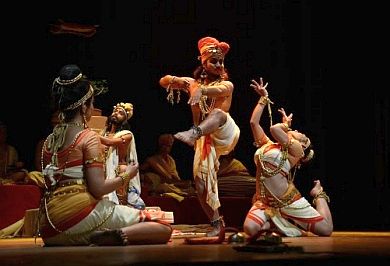





















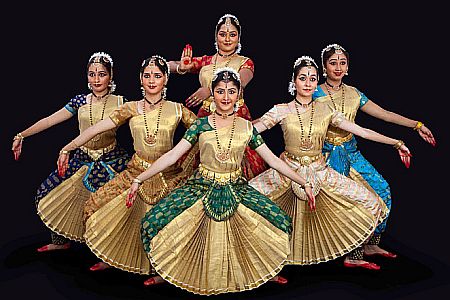



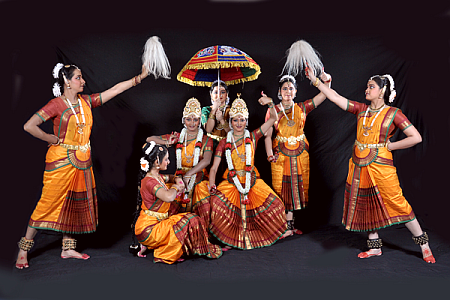














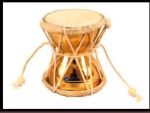 Abhinavagupta, in his typical style, provides a totally different sort of explanation to the term Tandava. According to him, the term Tāṇḍava is derived from the sounds like ‘Tando; tam-tam’, produced by the accompanying Damaru shaped drums. It follows the manner, in Grammar (vyākaraṇa), of naming an object, based on the sound it produces – śabda-anukṛti.
Abhinavagupta, in his typical style, provides a totally different sort of explanation to the term Tandava. According to him, the term Tāṇḍava is derived from the sounds like ‘Tando; tam-tam’, produced by the accompanying Damaru shaped drums. It follows the manner, in Grammar (vyākaraṇa), of naming an object, based on the sound it produces – śabda-anukṛti. 


